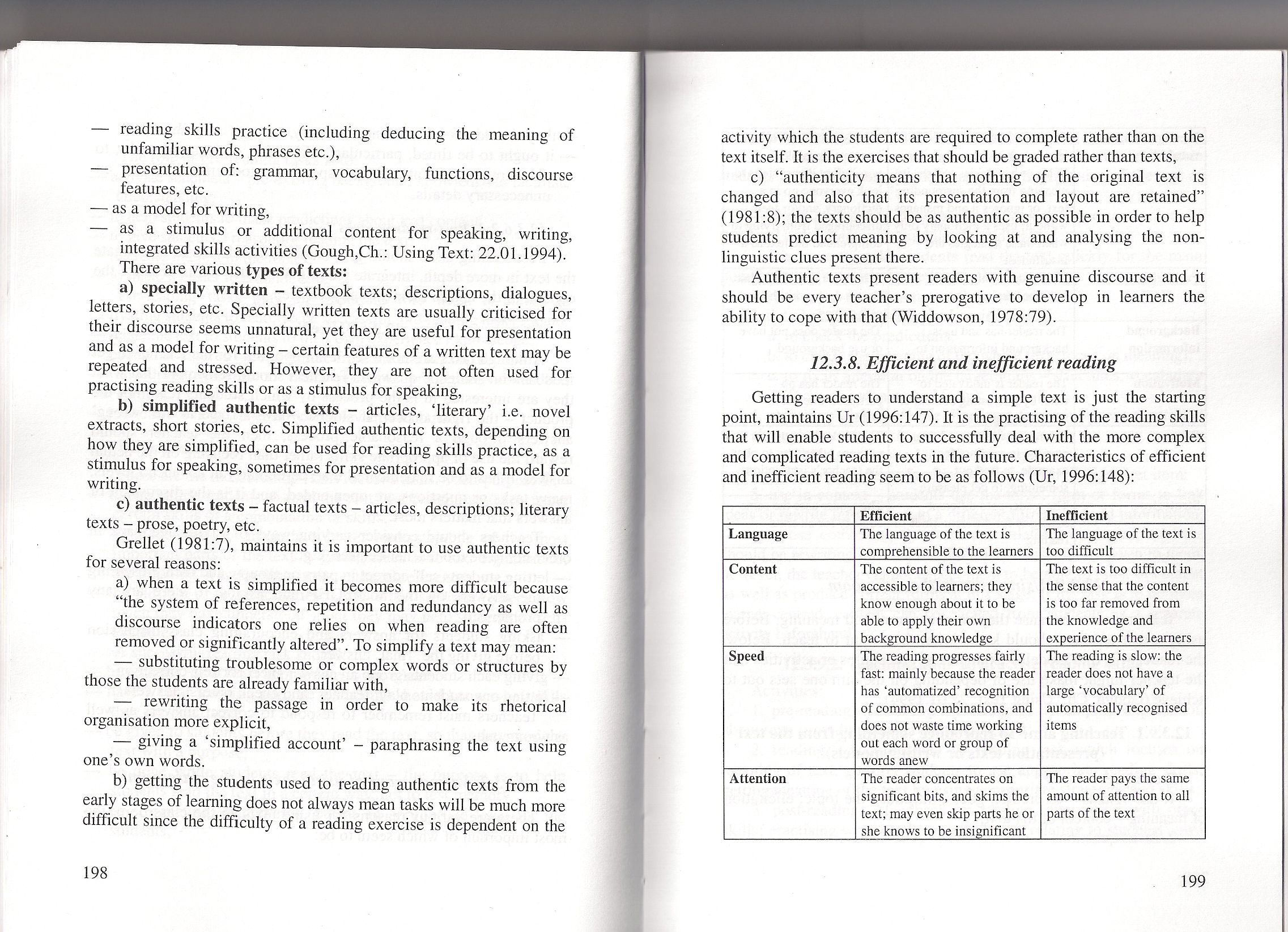skanowanie0099 (2)

— reading skills practice (including deducing the meaning of unfamiliar words, phrases etc.),
— presentation of: grammar, vocabulary, functions, discourse features, etc.
— as a model for writing,
— as a stimulus or additional content for speaking, writing, integrated skills activities (Gough,Ch.: Using Text: 22.01.1994). There are various types of texts:
a) specially written - textbook texts; descriptions, dialogues, letters, stories, etc. Specially written texts are usually criticised for their discourse seems unnatural, yet they are useful for presentation and as a model for writing - certain features of a written text may be repeated and stressed. However, they are not often used for practising reading skills or as a stimulus for speaking,
b) simplified authentic texts - articles, ‘literary’ i.e. novel extracts, short stories, etc. Simplified authentic texts, depending on how they are simplified, can be used for reading skills practice, as a stimulus for speaking, sometimes for presentation and as a model for writing.
c) authentic texts - factual texts - articles, descriptions; literary texts — prose, poetry, etc.
Grellet (1981:7), maintains it is important to use authentic texts for several reasons:
a) when a text is simplified it becomes morę difficult because “the system of references, repetition and redundancy as well as discourse indicators one relies on when reading are often removed or signiflcantly altered”. To simplify a text may mean:
— substituting troublesome or complex words or structures by those the students are already familiar with,
— rewriting the passage in order to make its rhetorical organisation morę explicit,
— giving a ‘simplified account’ - paraphrasing the text using one’s own words.
b) getting the students used to reading authentic texts from the early stages of leaming does not always mean tasks will be much morę difficult sińce the difficulty of a reading exercise is dependent on the activity which the students are reąuired to complete rather than on the text itself. It is the exercises that should be graded rather than texts,
c) “authenticity means that nothing of the original text is changed and also that its presentation and layout are retained” (1981:8); the texts should be as authentic as possible in order to help students predict meaning by looking at and analysing the non-linguistic clues present there.
Authentic texts present readers with genuine discourse and it should be every teacher’s prerogative to develop in leamers the ability to cope with that (Widdowson, 1978:79).
12.3.8. Efficient and inefficient reading
Getting readers to understand a simple text is just the starting point, maintains Ur (1996:147). It is the practising of the reading skills that will enable students to successfully deal with the morę complex and complicated reading texts in the futurę. Characteristics of efficient and inefficient reading sęem to be as follows (Ur, 1996:148):
|
Efficient |
Inefficient | |
|
Language |
The language of the text is comprehensible to the leamers |
The language of the text is too difficult |
|
Content |
The content of the text is accessible to leamers; they know enough about it to be able to apply their own background knowledge |
The text is too difficult in the sense that the content is too far removed from the knowledge and experience of the leamers |
|
Speed |
The reading progresses fairly fast: mainly because the reader has ‘automatized’ recognition of common combinations, and does not waste time working out each word or group of words anew |
The reading is slow: the reader does not have a large ‘vocabulary’ of automatically recognised items |
|
Attention |
The reader concentrates on significant bits, and skims the text; may even skip parts he or she knows to be insignificant |
The reader pays the same amount of attention to all parts of the text |
199
Wyszukiwarka
Podobne podstrony:
skanowanie0099 (2) — reading skills practice (including deducing the meaning of&nb
The Reading Skiils Purpose of teaching reading skills: Importance to realize the difference between
skanowanie0088 (2) To ensure proper understanding of his intentions, the author brings the readers t
154BIB LI O GRA PH1E CANONIALE 138. Evans Gillians, Hugh of St Victor on History and the meaning of
2. What do you think is the meaning of the headlines? The titles refer to problems associated with t
cóś01 VOCABULARY ..What Is the meaning of the underlined words? Circle the ietter
LANGUAGE AND SK1LLS TEST 4 A UNTTS 7-8 oREADING SKILLS1 Read a brochure about the Isles of Scilly.Fo
75 « The meanings of the word "aesthetic" have been the subject of fierce debatę in aborig
5 Rewrite the sentences. Use the words in Capital letters. Do not change the meaning of the
ZDIĘCIA0069 1 Check the meaning of the words in the Wordlist on page 137. Then put them into the cor
20101121�2 Explain briefly the meaning of each symptom, sign or abnormal condition, match thcm wlth
Word SleuthEach sentence has context clues to help you figurę out the meaning of the highlighted wor
Prereąuisites: students should know the techniques of selected athletics disciplines included in the
więcej podobnych podstron